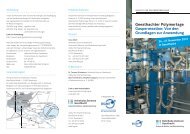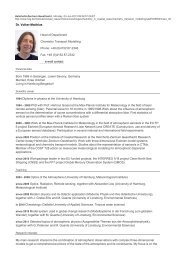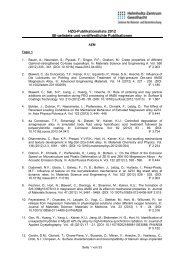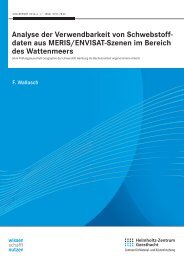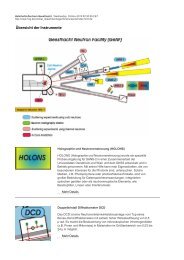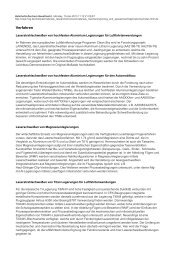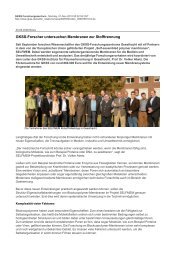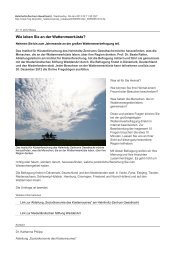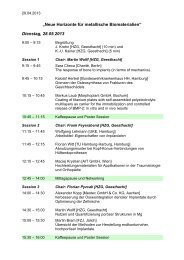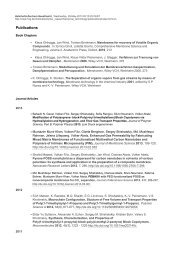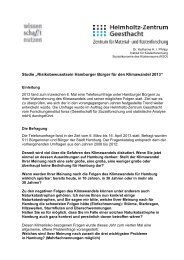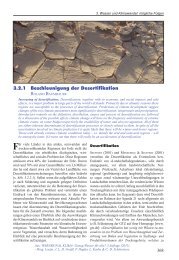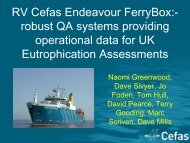High-resolution wave climate analysis in the Helgoland area - GKSS
High-resolution wave climate analysis in the Helgoland area - GKSS
High-resolution wave climate analysis in the Helgoland area - GKSS
You also want an ePaper? Increase the reach of your titles
YUMPU automatically turns print PDFs into web optimized ePapers that Google loves.
2.1 Methods, data and tools 7<br />
For <strong>the</strong> <strong>wave</strong> simulation <strong>in</strong> this study <strong>the</strong> K-model is used, which is a third generation<br />
spectral <strong>wave</strong> model adapted to small-scale shallow water applications. Third generation<br />
models are characterized by <strong>the</strong> transition to full two-dimensional discretization of <strong>the</strong><br />
<strong>wave</strong> spectrum <strong>in</strong>stead of artificial separation of <strong>the</strong> w<strong>in</strong>d and swell parts of spectrum. The<br />
development of third generation models started <strong>in</strong> mid 1980s by WAMDI Group [1988]. This<br />
approach has been successfully used for <strong>the</strong> major part of spectral <strong>wave</strong> models constructed<br />
for both open ocean applications (e.g. WAM-cycle4 (Gün<strong>the</strong>r et al. [1992])) and smallscale<br />
and shallow water applications (e.g. high-<strong>resolution</strong> version of WAM (Monbaliu et al.<br />
[2000]) or SWAN (Ris et al. [1999])). The K-model was developed on <strong>the</strong> basis of <strong>the</strong><br />
WAM-cycle4 model with some changes aim<strong>in</strong>g ma<strong>in</strong>ly at <strong>the</strong> adaptation of <strong>the</strong> model to<br />
small-scale coastal zone applications. With <strong>the</strong> <strong>in</strong>creas<strong>in</strong>g spatial and time <strong>resolution</strong>s and<br />
consideration of <strong>area</strong>s with shallow water and complex topography, <strong>the</strong> model faces <strong>the</strong><br />
problems of <strong>in</strong>homogeneity and non-stationarity of external fields. The ma<strong>in</strong> part of <strong>the</strong><br />
<strong>wave</strong> <strong>the</strong>ory was developed for idealized conditions which can be accepted for <strong>the</strong> most of<br />
medium-scale deep-water applications but need a strong revision and adaptation to <strong>the</strong> nearshore<br />
small-scale environment. The changes between WAM and K-model <strong>in</strong>clude transitions<br />
from <strong>the</strong> frequency-direction (f, θ) to <strong>the</strong> <strong>wave</strong>number-direction (k, θ) doma<strong>in</strong>. This allows<br />
avoid<strong>in</strong>g additional multipliers with partial time derivatives <strong>in</strong> <strong>the</strong> balance equation, which<br />
is crucial <strong>in</strong> non-stationary cases (Schneggenburger [1998]). Ano<strong>the</strong>r difference is related<br />
to <strong>the</strong> form of <strong>the</strong> source function. Non-l<strong>in</strong>ear <strong>wave</strong>-<strong>wave</strong> <strong>in</strong>teractions have been neglected<br />
follow<strong>in</strong>g <strong>the</strong> reason<strong>in</strong>g of Schneggenburger [1998], who argued that <strong>in</strong> shallow water <strong>the</strong><br />
assumptions of homogeneity for <strong>the</strong> application of this <strong>the</strong>ory are violated. Instead, a nonl<strong>in</strong>ear<br />
dissipation source function (Gün<strong>the</strong>r and Rosenthal [1997] or Schneggenburger et al.<br />
[1997]), account<strong>in</strong>g for <strong>the</strong> dissipation by <strong>wave</strong> turbulence, is used. In <strong>the</strong> K-model energy<br />
<strong>in</strong>put by w<strong>in</strong>d is parameterized by a modified Philips l<strong>in</strong>ear function (Cavaleri and Rizzoli<br />
[1981]) and a modified Snyder exponential function (WAMDI Group [1988]) similar to <strong>the</strong><br />
WAM model. Bottom dissipation is taken <strong>in</strong>to account accord<strong>in</strong>g to Hasselmann et al.<br />
[1973].<br />
The modeled and measured <strong>wave</strong> fields were orig<strong>in</strong>ally given <strong>in</strong> <strong>the</strong> form of a <strong>wave</strong><br />
spectrum but for practical reasons different representations of spectrum or <strong>in</strong>tegrated parameters<br />
are used. This provides <strong>the</strong> opportunity to relate model results to observed data <strong>in</strong><br />
a sense that <strong>in</strong>tegrated parameters can be easily statistically <strong>in</strong>terpreted as characteristics<br />
of <strong>the</strong> sea state. The most usable <strong>in</strong>tegrated parameters are <strong>the</strong> moments mn:<br />
�<br />
mn = F (f, θ)f n dfdθ, n = −1, 0, 1, 2<br />
and quantities related to <strong>the</strong>m. The zeroth order moment m0 is <strong>the</strong> total variance of<br />
<strong>the</strong> spectrum which proportional to <strong>the</strong> total energy and def<strong>in</strong>es ano<strong>the</strong>r frequently used<br />
<strong>in</strong>tegrated parameter <strong>the</strong> significant <strong>wave</strong> height (SWH):<br />
Hs = 4 √ m0<br />
which corresponds to <strong>the</strong> mean of <strong>the</strong> highest third of <strong>the</strong> observed <strong>wave</strong>s (Longuett-Higg<strong>in</strong>s<br />
et al. [1963]). Different <strong>in</strong>tegrated periods can also be useful. The peak period Tp is def<strong>in</strong>ed



